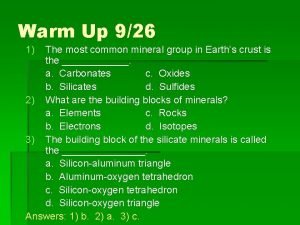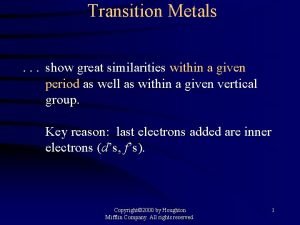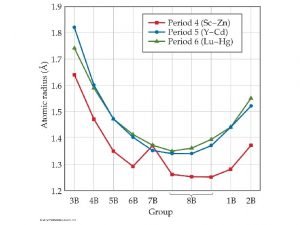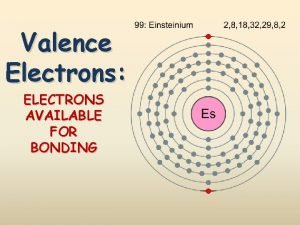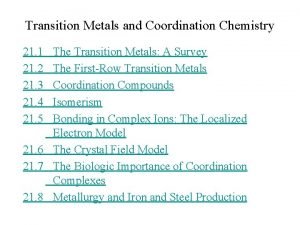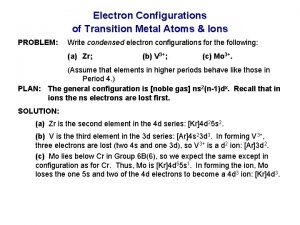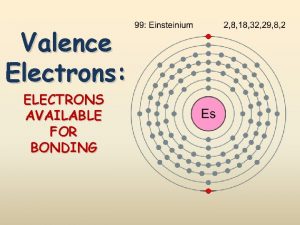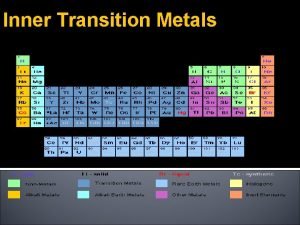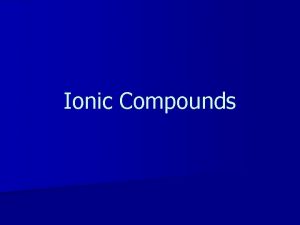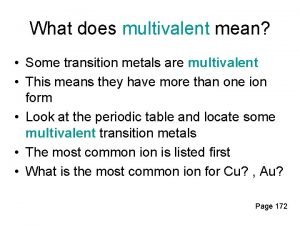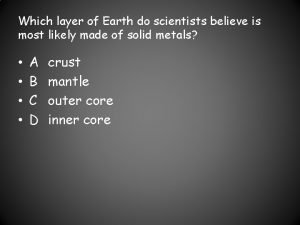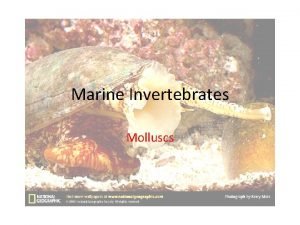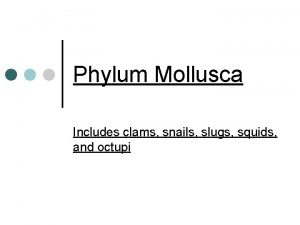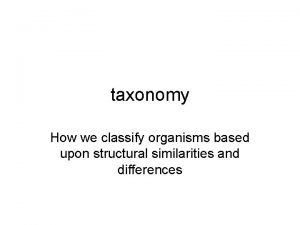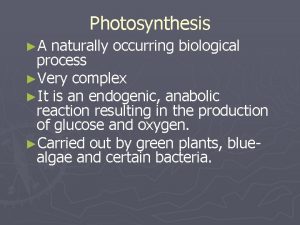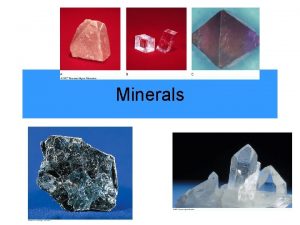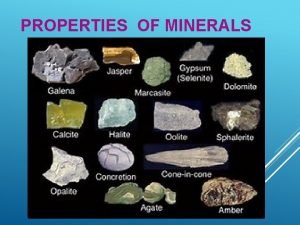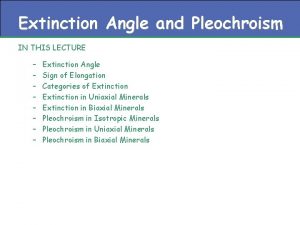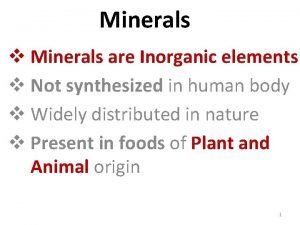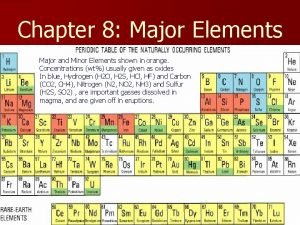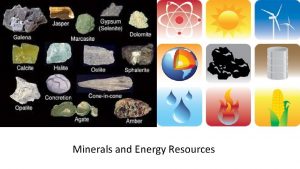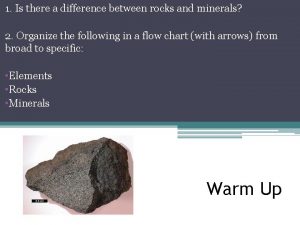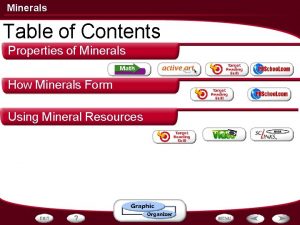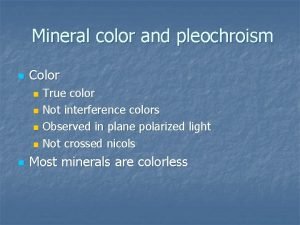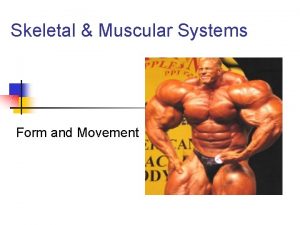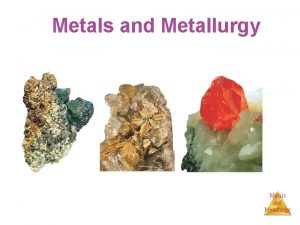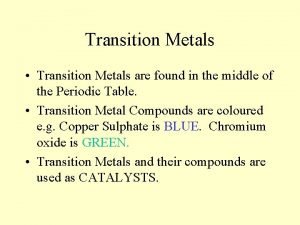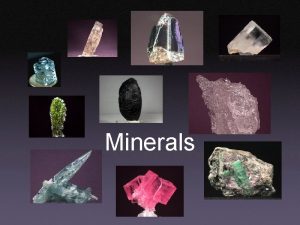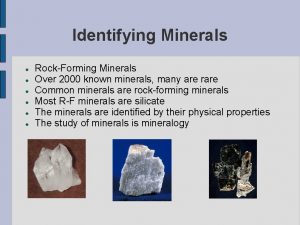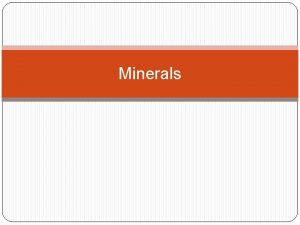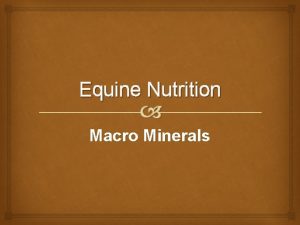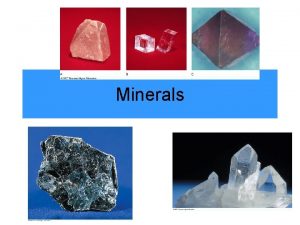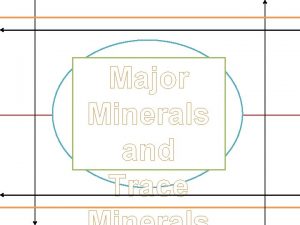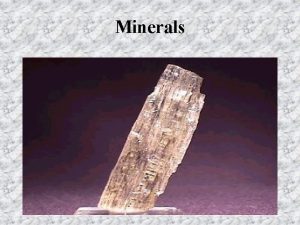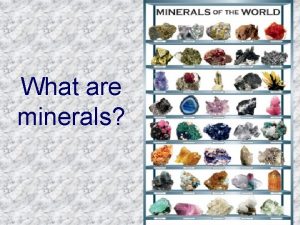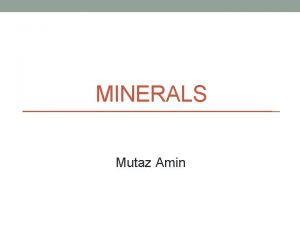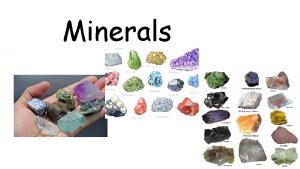Minerals Most metals including transition metals are found






![Irregular Electron Configurations • • • Expected Cr = [Ar]4 s 23 d 4 Irregular Electron Configurations • • • Expected Cr = [Ar]4 s 23 d 4](https://slidetodoc.com/presentation_image_h2/3a7e574b03b7e880fcc664e87a224e02/image-7.jpg)

















![Examples of Naming Coordination Compounds Name [Cr(H 2 O)5 Cl]Cl 2 Name K 3[Fe(CN)6] Examples of Naming Coordination Compounds Name [Cr(H 2 O)5 Cl]Cl 2 Name K 3[Fe(CN)6]](https://slidetodoc.com/presentation_image_h2/3a7e574b03b7e880fcc664e87a224e02/image-25.jpg)


















































- Slides: 75

Minerals • Most metals, including transition metals, are found in solid inorganic compounds known as minerals. • Minerals are named by common, not chemical, names. Transition Metals © 2012 Pearson Education, Inc.

Lecture Presentation Chapter 24 Transition Metals and Coordination Compounds Sherril Soman Grand Valley State University © 2014 Pearson Education, Inc.

Gemstones • The colors of rubies and emeralds are both due to the presence of Cr 3+ ions; the difference lies in the crystal hosting the ion. Al 3+ Some ions in Al 2 O 3 are replaced by Cr 3+. Some Al 3+ ions in Be 3 Al 2(Si. O 3)6 are replaced by Cr 3+.

Properties and Electron Configuration of Transition Metals • The properties of the transition metals are similar to each other. – And very different from the properties of the main group metals – High melting points, high densities, moderate to very hard, and very good electrical conductors • The similarities in properties come from similarities in valence electron configuration; they generally have two valence electrons.

Electron Configuration • For first and second transition series – ns 2(n− 1)dx – First = [Ar]4 s 23 dx; second = [Kr]5 s 24 dx • For third and fourth transition series – ns 2(n− 2)f 14(n− 1)dx • Some individuals deviate from the general pattern by “promoting” one or more s electrons into the underlying d to complete the subshell. – Group 1 B • Form ions by losing the ns electrons first, then

Electron Configurations • Irregular We know that because of sublevel splitting, the 4 s sublevel is lower in energy than the 3 d; and therefore, the 4 s fills before the 3 d. • However, the difference in energy is not large. • Some of the transition metals have irregular electron configurations in which the ns only partially fills before the (n− 1)d or doesn’t fill at all. • Therefore, their electron configuration must be found experimentally.
![Irregular Electron Configurations Expected Cr Ar4 s 23 d 4 Irregular Electron Configurations • • • Expected Cr = [Ar]4 s 23 d 4](https://slidetodoc.com/presentation_image_h2/3a7e574b03b7e880fcc664e87a224e02/image-7.jpg)
Irregular Electron Configurations • • • Expected Cr = [Ar]4 s 23 d 4 Cu = [Ar]4 s 23 d 9 Mo = [Kr]5 s 24 d 4 Ru = [Kr]5 s 24 d 6 Pd = [Kr]5 s 24 d 8 • • • Found Experimentally Cr = [Ar]4 s 13 d 5 Cu = [Ar]4 s 13 d 10 Mo = [Kr]5 s 14 d 5 Ru = [Kr]5 s 14 d 7 Pd = [Kr]5 s 04 d 10

Atomic • The atomic radii of all the. Size transition metals are very similar. – Small increase in size down a column • The third transition series atoms are about the same size as the second. – The lanthanide contraction is the decrease in expected atomic size for the third transition series atoms that come after the lanthanides.

Why Aren’t the Third Transition Series Atoms Bigger? • 14 of the added 32 electrons between the second and third series go into 4 f orbitals. • Electrons in f orbitals are not as good at shielding the valence electrons from the pull of the nucleus. • The result is a greater effective nuclear charge increase and therefore a stronger pull on the valence electrons—the lanthanide contraction.

Ionization Energy • The first IE of the transition metals slowly increases across a series. • The first IE of the third transition series is generally higher than the first and second series – Indicating the valence electrons are held more tightly – why? – Trend opposite to main group elements

Electronegativity • The electronegativity of the transition metals slowly increases across a series. – Except for last element in the series • Electronegativity slightly increases between first and second series, but the third transition series atoms are about the same as the second.

Oxidation States • Unlike main group metals, transition metals often exhibit multiple oxidation states. • They vary by 1. • Highest oxidation state is the same as the group number for groups 3 B to 7 B.

Complex • When a monatomic cation. Ions combines with multiple monatomic anions or neutral molecules it makes a complex ion. • The attached anions or neutral molecules are called ligands. • The charge on the complex ion can then be positive or negative, depending on the numbers and types of ligands attached.

Coordination Compounds • When a complex ion combines with counterions to make a neutral compound it is called a coordination compound. • The primary valence is the oxidation number of the metal. • The secondary valence is the number of ligands bonded to the metal. – Coordination number • Coordination numbers range from 2 to 12, with the most common being 6 and 4. Co. Cl 3 • 6 H 2 O = [Co(H 2 O)6]Cl 3

Coordination Compound

Complex Ionis. Formation • Complex ion formation a type of Lewis acid–base reaction. • A bond that forms when the pair of electrons is donated by one atom is called a coordinate covalent bond.

with Teeth • Some. Ligands ligands can form Extra more than one coordinate covalent bond with the metal atom. – Lone pairs on different atoms that are separated enough so that both can bond to the metal • A chelate is a complex ion containing a multidentate ligand. – The ligand is called the chelating agent.

Ligands

EDTA – A Polydentate Ligand

Complex Ions with Polydentate Ligands

Geometries in Complex Ions

Naming Coordination Compounds 1. Determine the name of the noncomplex ion. 2. Determine the ligand names and list them in alphabetical order. 3. Determine the name of the metal cation. 4. Name the complex ion b: a) Naming each ligand alphabetically, adding a prefix in front of each ligand to indicate the number found in the complex ion b) Following with the name of the metal cation 5. Write the name of the cation followed by the name of the anion.

Common Ligands

Common Metals found in Anionic Complex Ions
![Examples of Naming Coordination Compounds Name CrH 2 O5 ClCl 2 Name K 3FeCN6 Examples of Naming Coordination Compounds Name [Cr(H 2 O)5 Cl]Cl 2 Name K 3[Fe(CN)6]](https://slidetodoc.com/presentation_image_h2/3a7e574b03b7e880fcc664e87a224e02/image-25.jpg)
Examples of Naming Coordination Compounds Name [Cr(H 2 O)5 Cl]Cl 2 Name K 3[Fe(CN)6] Identify the cation and anion, and the name of the simple ion. [Cr(H 2 O)5 Cl]2+ is a complex cation; Cl− is chloride. K+ is potassium; [Fe(CN)6]3− is a complex ion. Give each ligand a name and list them in alphabetical order. H 2 O is aqua; Cl− is chloro. CN− is cyano. Cr 3+ is chromium(III). Fe 3+ is ferrate(III) because the complex ion is anionic. [Cr(H 2 O)5 Cl]2+ is pentaquochlorochromium(III). [Fe(CN)6]3− is hexacyanoferrate(III). [Cr(H 2 O)5 Cl]Cl 2 is pentaquochlorochromium(III) chloride. K 3[Fe(CN)6] is potassium hexacyanoferrate(III). Name the metal ion. Name the complex ion by adding prefixes to indicate the number of each ligand followed by the name of the metal ion. Name the compound by writing the name of the cation before the anion. The only space is between ion names.

Isomers • Structural isomers are molecules that have the same number and type of atoms, but they are attached in a different order. • Stereoisomers are molecules that have the same number and type of atoms, and that are attached in the same order, but the atoms or groups of atoms point in a different spatial direction.

Types of Isomers

Linkage Isomers • Linkage isomers are structural isomers that have ligands attached to the central cation through different ends of the ligand structure. Yellow complex = pentamminonitrocobalt(III) Red complex = pentamminonitritocobalt(III)

Ligands Capable of Linkage Isomerization

Isomersthat • Geometric isomers are stereoisomers differ in the spatial orientation of ligands. • cis–trans isomerism in square-planar complexes MA 2 B 2

• In cis–trans isomerism, two identical ligands are Geometric Isomers either adjacent to each other (cis) or opposite to each other (trans) in the structure. • cis–trans isomerism in octahedral complexes MA 4 B 2

• In fac–mer. Geometric isomerism three identical ligands in an Isomers octahedral complex either are adjacent to each other making one face (fac) or form an arc around the center (mer) in the structure. • fac–mer isomerism in octahedral complexes MA 3 B 3

• Optical Isomers Optical isomers are stereoisomers that are nonsuperimposable mirror images of each other. [Co(en)3]3+

• Bonding in Coordination Compounds: Valence Bond Theory Bonding takes place when the filled atomic orbital on the ligand overlaps an empty atomic orbital on the metal ion. • It explains geometries well, but doesn’t explain color or magnetic properties.

Common Hybridization Schemes in Complex Ions

• Bonding in Coordination Compounds: Crystal Theory Bonds form due to Field the attraction of the electrons on the ligand for the charge on the metal cation. • Electrons on the ligands repel electrons in the unhybridized d orbitals of the metal ion. • The result is the energies of the d orbitals are split. • The difference in energy depends on the complex formed and the kinds of ligands. – Crystal field splitting energy – Strong field splitting and weak field splitting

Crystal Field Splitting The ligands in an octahedral complex are located in the same space as the lobes of the orbitals.

Crystal Field Splitting The repulsions between electron pairs in the ligands and any potential electrons in the d orbitals result in an increase in the energies of these orbitals.

Crystal Field Splitting The other d orbitals lie between the axes and have nodes directly on the axes, which results in less repulsion and lower energies for these three orbitals.

Splitting of d Orbital Energies Due to Ligands in an Octahedral Complex The size of the crystal field splitting energy, D, depends on the kinds of ligands and their relative positions on the complex ion, as well as the kind of metal ion and its oxidation state.

Color and • Transition metal ions. Complex show many. Ions intense colors in host crystals or solution. • The color of light absorbed by the complexed ion is related to electronic energy changes in the structure of the complex. – The electron “leaping” from a lower energy state to a higher energy state

Complex Ion Color • The observed color is the complementary color of the one that is absorbed.

Complex Ion Color and Crystal Field Strength • The colors of complex ions are due to electronic transitions between the split d sublevel orbitals. • The wavelength of maximum absorbance can be used to determine the size of the energy gap between the split d sublevel orbitals. Ephoton = hc/l = D

Ligands and Crystal Field Strength • The size of the energy gap depends on what kind of ligands are attached. ü Strong field ligands include CN─ > NO 2─ > en > NH 3. ü Weak field ligands include H 2 O > OH─ > F─ > Cl─ > Br─ > I─. • The size of the energy gap also depends on the type of cation. üIncreases as the charge on the metal cation increases üCo 3+ > Cr 3+ > Fe 2+ > Co 2+ > Ni 2+ > Mn 2+

Magnetic Properties and Crystal Field Strength • The electron configuration of the metal ion with split d orbitals depends on the strength of the crystal field. • The fourth and fifth electrons will go into the higher energy if the field is weak and the energy gap is small, leading to unpaired electrons and a paramagnetic complex. • The fourth through sixth electrons will pair the electrons in the dxy, dyz, and dxz if the field is strong and the energy gap is large, leading to paired electrons and a diamagnetic complex.

Low Spin and High Spin Complexes Diamagnetic Paramagnetic Low-spin complex High-spin complex Only electron configurations d 4, d 5, d 6, or d 7 can have low or high spin.

Tetrahedral Geometry and Crystal Field Splitting • Because the ligands interact more strongly with the planar orbitals in the tetrahedral geometry, their energies are raised. • This reverses the order of energies compared to the octahedral geometry. • Almost all tetrahedral complexes are high spin because of reduced metal orbital—ligand interaction.

Crystal Field Splitting in the Tetrahedral Geometry

Square Planar Geometry and Crystal Field Splitting • d 8 metals – Pt 2+, Pd 2+, Ir+, Au 3+ • The most complex splitting pattern • Almost all – low-spin complexes

Applications of Coordination Compounds • Extraction of metals from ores – Silver and gold as cyanide complexes – Nickel as Ni(CO)4(g) • Use of chelating agents in heavy metal poisoning – EDTA for Pb poisoning • Chemical analysis – Qualitative analysis for metal ions • Blue = Co. SCN+ • Red = Fe. SCN 2+ • Ni 2+ and Pd 2+ form insoluble colored precipitates with dimethylglyoxime.

Biomolecules

• Applications of Coordination Compounds Commercial coloring agents ü Prussian blue = mixture of hexacyano. Fe(II) and Fe(III) ØInks, blueprinting, cosmetics, paints

• Applications of Coordination Compounds Biomolecules ü Porphyrin ring

• Applications of Coordination Compounds Biomolecules ü Cytochrome C ü Hemoglobin

• Applications of Coordination Compounds Biomolecules ü Chlorophyll

Applications of Coordination Compounds • Carbonic anhydrase – Catalyzes the reaction between water and CO 2 – Contains tetrahedrally complexed Zn 2+

Applications of Coordination Compounds • Drugs and therapeutic agents – Cisplatin • Anticancer drug

Complexes • Commonly, transition metals can have molecules or ions that bond to them. • These give rise to complex ions or coordination compounds. Transition Metals © 2012 Pearson Education, Inc.

Ligands The molecules or ions that bind to the central metal are called ligands (from the Latin ligare, meaning “to bind”). Transition Metals © 2012 Pearson Education, Inc.

Common Ligands The table above contains some ligands commonly found in complexes. © 2012 Pearson Education, Inc. Transition Metals

Common Ligands Monodentate ligands coordinate to one site on the metal, bidentate to two, and so forth. Transition Metals © 2012 Pearson Education, Inc.

Common Ligands Bi and polydentate ligands are also called chelating agents. Transition Metals © 2012 Pearson Education, Inc.

Chelates in Biological Systems • There are many transition metals that are vital to human life. • Several of these are bound to chelating agents. Transition Metals © 2012 Pearson Education, Inc.

Chelates in Biological Systems • For instance, the iron in hemoglobin carries O 2 and CO 2 through the blood. • Carbon monoxide and cyanide are poisonous because they will bind more tightly to the iron than will oxygen. Transition Metals © 2012 Pearson Education, Inc.

Nomenclature in Coordination Chemistry 1. In naming complexes that are salts, the name of the cation is given before the name of the anion. Transition Metals © 2012 Pearson Education, Inc.

Nomenclature in Coordination Chemistry 2. In naming complex ions or molecules, the ligands are named before the metal. Ligands are listed in alphabetical order, regardless of their charges. Transition Metals © 2012 Pearson Education, Inc.

Nomenclature in Coordination Chemistry 3. The names of anionic ligands end in the letter o, but electrically neutral ligands ordinarily bear the name of the molecules. Transition Metals © 2012 Pearson Education, Inc.

Nomenclature in Coordination Chemistry 4. Greek prefixes (di-, tri-, tetra-, etc. ) are used to indicate the number of each kind of ligand when more than one is present. If the ligand contains a Greek prefix or is polydentate, the prefixes bis-, tris-, tetrakis-, etc. are used and the ligand name is placed in parentheses. Transition Metals © 2012 Pearson Education, Inc.

Nomenclature in Coordination Chemistry 5. If the complex is an anion, its name ends in -ate. 6. The oxidation number of the metal is given in parentheses in Roman numerals following the name of the metal. Transition Metals © 2012 Pearson Education, Inc.

Isomers • Isomers have the same molecular formula but a different arrangement of atoms. • There are two main subgroupings: structural isomers and stereoisomers. Transition Metals © 2012 Pearson Education, Inc.

Linkage Isomers In linkage isomers the ligand is bound to the metal by a different atom. Transition Metals © 2012 Pearson Education, Inc.

Geometric Isomers • In geometric isomers, the ligands have a different spatial relationship. • In the complexes above, the chlorines can be adjacent to each other (cis) or opposite each other (trans). © 2012 Pearson Education, Inc. Transition Metals

Optical Isomers Optical isomers, or enantiomers, are non-superimposable mirror images of one another. Transition Metals © 2012 Pearson Education, Inc.

Crystal-Field Theory The spectrochemical series ranks ligands in order of their ability to increase the energy gap between d orbitals. Transition Metals © 2012 Pearson Education, Inc.

Crystal-Field Theory The stronger the crystal-field strength of the ligand, the larger the energy gap between d orbitals, and the shorter the wavelength of light absorbed by the complex. © 2012 Pearson Education, Inc. Transition Metals
 Mikael ferm
Mikael ferm Minerals found in karnataka
Minerals found in karnataka Where are metals found on the periodic table
Where are metals found on the periodic table Most abundant minerals in earth's crust
Most abundant minerals in earth's crust Metal vs nonmetal
Metal vs nonmetal Properties of materials grade 7
Properties of materials grade 7 Periodic table metals and nonmetals
Periodic table metals and nonmetals Matter and materials (grade 7 worksheets)
Matter and materials (grade 7 worksheets) Examples of alloy metals
Examples of alloy metals Example of non metal
Example of non metal Transition metals display great similarities
Transition metals display great similarities Inner transition metals
Inner transition metals Ionization energy for transition metals
Ionization energy for transition metals Valence electrons for transition metals
Valence electrons for transition metals A linear complex ion with ligands on the x-axis
A linear complex ion with ligands on the x-axis Transition metal electron configuration
Transition metal electron configuration Ionic compounds containing transition metals
Ionic compounds containing transition metals Group with 6 valence electrons
Group with 6 valence electrons Inner transition metals definition
Inner transition metals definition First row transition metals
First row transition metals Atoms form
Atoms form Multivalent metals list
Multivalent metals list Soil that forms on unconsolidated deposits is called
Soil that forms on unconsolidated deposits is called Which layer of earth is most likely made of solid metals
Which layer of earth is most likely made of solid metals What is the most reactive family of metals? *
What is the most reactive family of metals? * Square pyramid faces edges vertices
Square pyramid faces edges vertices Printed words including dialogue
Printed words including dialogue Animals including humans year 6
Animals including humans year 6 Animals including humans year 4
Animals including humans year 4 Including samuel discussion questions
Including samuel discussion questions It encompasses several different aspects, including
It encompasses several different aspects, including Eight dollars the price of a movie these days
Eight dollars the price of a movie these days Invertebrates including snails slugs and mussels
Invertebrates including snails slugs and mussels Animals including humans clipart
Animals including humans clipart Ice method examples
Ice method examples Printed words including dialogue
Printed words including dialogue The mutcd states all workers including emergency responders
The mutcd states all workers including emergency responders Invertebrates including snails slugs and mussels
Invertebrates including snails slugs and mussels In the name of allah most beneficent most merciful
In the name of allah most beneficent most merciful Beneficent pronunciation
Beneficent pronunciation Most general to most specific classification
Most general to most specific classification In the name of god most gracious most merciful
In the name of god most gracious most merciful Most general to most specific classification
Most general to most specific classification In the name of allah the most beneficent the most merciful
In the name of allah the most beneficent the most merciful In the name of god most gracious prayer
In the name of god most gracious prayer Aqeedah meaning
Aqeedah meaning Allah the most gracious
Allah the most gracious Most general to most specific classification
Most general to most specific classification In the name of allah the most gracious
In the name of allah the most gracious In the name of god the most gracious the most merciful
In the name of god the most gracious the most merciful The most
The most In the name of allah the beneficent the merciful
In the name of allah the beneficent the merciful Most general to most specific classification
Most general to most specific classification Nearly 4000 minerals have been named.
Nearly 4000 minerals have been named. What type of rock is this
What type of rock is this Minerals and fuels
Minerals and fuels Color properties of minerals
Color properties of minerals Biotitie
Biotitie Barre minerals
Barre minerals Materials or substances such as minerals forests
Materials or substances such as minerals forests Crystal shape
Crystal shape Elements are moved between minerals during metamorphism by:
Elements are moved between minerals during metamorphism by: Parallel extinction examples
Parallel extinction examples Iron deficiency anemia smear
Iron deficiency anemia smear Major and minor elements
Major and minor elements Minerals in water
Minerals in water Minerals and fuels
Minerals and fuels Characteristics of a mineral
Characteristics of a mineral What kind of rock is this
What kind of rock is this What are vitamins functions
What are vitamins functions What minerals do plants need
What minerals do plants need Ravine erosion
Ravine erosion Uniaxial optic axis figure
Uniaxial optic axis figure The uses of minerals
The uses of minerals True colors of minerals
True colors of minerals Stores minerals and anchors muscles
Stores minerals and anchors muscles



